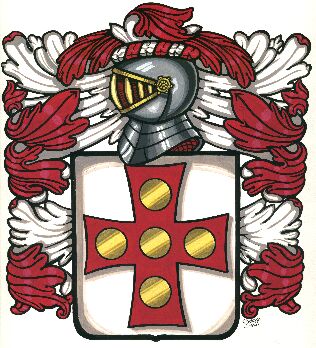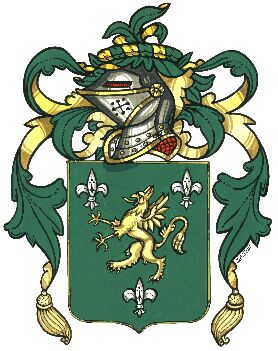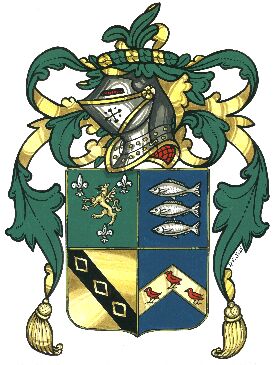I
Fact or Fiction?
Did our family in early times have a coat of arms is an interesting question. A heraldic consultant in both Australia and in Cornwall have been consulted and while the Australian firm produced for one member of our family a lovely crest with a white and red shield showing three squirrels the Cornish consultant said that while he has a very comprehensive index of Cornish heraldry of all periods, he can find no reference to any coat of arms or crest for Trevethan or Trevathan. However Lysons’ “Magna Britannia”, Cornish section, refers to Porthcothan or Percothan in St. Merryn parish, “formerly belonging to the family of Trevethan, for one of whom there is a memorial in the Parish Church" pictured to the right. Lysons’ was written c.1810. Thus, this family of Trevethans were presumably of some substance, minor gentry, who may possibly have used a coat of arms. St. Merryn along with St. Issey is the area where our family lived in Cornwall before leaving for New Zealand. There are
however arms for the family of Trevarthian, As a result of extensive research you will have read earlier that our Cornish Trevethans are in fact the same family as the one that came from Porthcothan. It gave me a great thrill on my two visits to Cornwall to see our family’s coat of arms displayed still today, even if it was up side down, on the wall in the St. Merryn church (see page on the Trevethans of Porthcothan). The blason, or technical heraldic description, would be: “Argent, on a cross patty gules, five besants”, i.e. A white/silver shield, with a red cross with spreading arms bearing five gold roundels. (Besants were named after gold coins of Byzantium). “Gules” covers any shade of red. The helmet, of steel and in profile, is the type usual for “gentlemen” other than nobility, and its “mantling” or drapery and the surmounting wreath are in the main colours of the shield, red reversed white. It is possible that a crest (helmet decoration) originally appeared above the wreath, but not all coats of arms had such a crest. In the drawing a curl of mantling has been included over the wreath to complete the design. The colour of the roundels is not absolutely clear, and it is possible, though somewhat less likely, that they could be white/silver, in which case they would be described as “plates” rather than besants. In this, as in most cases, the reason for adopting this design is probably not discoverable. Many fanciful tales have been made up in later years to explain coats of arms, e.g. granted for valiant service, crosses representing Crusader ancestors, etc., but the fact is that most were granted or adopted simply as distinctive family emblems to indicate a certain position in society. Originally coats of arms were adopted by great feudal lords and military leaders, but gradually came to be used by anyone with any claim to social status, and by merchants and various religious and civic bodies. In Europe arms were widely used among all social classes, including craftsmen and peasants. Arms are no longer necessarily associated with social status and are adopted by many of no particular eminence simply to symbolize their pride and interest in the family. Since the establishment of the "College of Arms" College of Arms in London in 1484, the official view has been that only arms granted or confirmed by the Royal Heralds, under the authority of the Earl Marshal, are recognized. However, over the centuries many individuals, families and bodies have simply adopted arms for themselves. Adoption of arms identical with those already in use cannot be justified, unless direct male descent from the original bearers is provable, but where official control of heraldry is actually or virtually non-existent the adoption of new arms is more acceptable. Our coat of arms, as far as can be traced, is unique and not identical to that used by any other family. It would seem however that this coat of arms was simply adopted by the family as extensive searches in the grant books and the volumes of Heralds’ Visitations (c1530-1680) held by the College of Arms in London has failed to find any evidence of the granting of our coat of arms to William Trevethuan of Porthcothan. Some of the St. Aubyn family of St. Michael’s Mount, etc. used a white shield, plain red cross with five besants, and some branches of the family surnamed Cornwall had a white shield with a black splayed cross with five besants, but these are sufficiently different from ours to rule out any definite connection. When the Royal Heralds were authorized to make “visitations” of the various counties of England and Wales, up to approximately the end of the 17th century, and when the Court of Chivalry was actively functioning, there was some official control, but since then this is virtually non-existent. The situation is somewhat different in Scotland, where Lord Lyon King of Arms has full statutory powers, and some heraldic authorities elsewhere have theoretical control, more or less enforceable. Grants of arms are still made in the U.K. to anyone prepared to pay the fee (currently some 1,200 pounds in England and Wales) provided the applicant is not of notoriously unsuitable character. All of this most interesting information was supplied by a heraldic consultant, Dennis Ivall, of Cornwall who also drew the drawing of our coat of arms from a photo I took while in the St. Merryn church at the time of our visit. More recent research takes our family back into the 1400’s with the marriage of John Trevithven and Margaret Roche and the discovery that an interesting coat of arms for this branch of our family exists.
The blason, or technical heraldic description for this quartered Arms is: 1. Vert, griffin segreant between three fleurs-de-lys Or. 2. Azure, three roaches naiant in pale Argent. 3. Or, on a bend sable three mascles of the first. 4. Azure, on a chevron Or, three birds gules. Or = gold. Vert = green. Azure = blue. Gules = red. “Segreant” is the same as rampant, when referring to a griffin. “Tinctures” are the colours and metals. “naiant” means swimming, i.e. when a fish is horizontal, not leaping or diving. “In pale” means the objects are above one another, in the form of a vertical paling. “Of the first” means the same colour or metal as the first mentioned (for that quarter). I have a lovely coloured photocopy of the original which I referred to Mr. Dennis Ivall, the heraldic consultant from Cornwall. He reported that one quarter of this coat of arms appears in “Burke’s General Armoury” under Trevithern. Burke’s General Armory gives the griffin and the fleuss deilys as “or” = gold, but this is probably a slip of the pen. Of the other three quarters of this shield, the second he confirmed as being for the family of Roche which has branches in both Devon and Cornwall. The Roche arms also appear in “Burke’s General Armory” with the same biographical details. The xe "Coat of Arms:Roche"Roche coat of arms is the three fish presumably representing roaches, as a pun on the name. Quite a number of coats of arms are recorded for the name Roche, in various spellings, mostly showing the three fish, but some in different colours. Of the bottom two quarters the left one with the bend (diagonal band) he thought could be for Burges. There are a dozen or so coats of arms for this name in Burke’s General Armory and interestingly enough there is a Treveth an Burges marriage 120 years latter when Henry Trevethan married Grace Burges. The Burges coat of arms are not exactly the same but very similar. The forth quarter he was unable to identify. The xe "Coat of Arms:quartering"quartering or joining together of family coat of arms is not uncommon but the theory is quite complicated. The basics are that the children of an armigerous man marrying a daughter of an armigerous family could quarter her coat of arms with his, provided that she had no brothers surviving to bear the arms. In these circumstances she was described as an “heraldic heiress”. Furthermore, if her family already had additional quarterings from previous marriages in her family these quarterings too could be adopted by her children. Quartering need not be limited to four, but could run into dozens, or even hundreds on occasions! Hence the four-quartered coat of Trevithven could represent a marriages between Trevithen and Roche and later on with two other “heraldic heiresses”, or with Margaret Roche whose family already had two other quarterings in their Arms. In fact, in this case, that is what had happened. The records of the College of Arms in London confirm that this four-quartered Coat of Arms were those of xe "TREVITHVEN, John" John Trevithven who married xe "ROCHE, Margaret" Margaret Roche. Her father, xe "ROCHE, William" William Roche had three children, Henry, Margaret and Jane. Henry died without issue thus making both his sisters, Margaret and Jane “heraldic heiresses” and therefore able to transmit the xe "Roche Arms" Roche Arms and any quarterings to their husbands arms. It is complicated enough if all the various arms were officially granted or confirmed, but families could take on the quarterings without official say-so, and were not always too fussy as to the genuineness or accuracy of the arms they quartered, or even of their own! The third quarter is therefore for the family of xe "Polmarva Arms" Polmarva and it is necessary to go back around a hundred years to Margaret Roche’s three greats grandfather, who’s wife was a Polmarva, to establish how the family came to have these arms quartered into the Rouche Arms. It was Margaret’s grandmother xe "PAGE, Katherine" Katherine Page who bought forward the forth quarter to make up the total Arms used by John Trevithven. The College of Arms made three visitations to Cornwall in the years 1531, 1573 and 1620. At the time of the first visitation the Trevithven family were considered gentry and were, therefore, included though at the time no Arms were recorded for them. By the time of the second visitation Arms were recorded and these are the ones in the illistration above. When the third visitation was made the family were not recorded as being in the county an interesting fact worth some extra research.
The griffin segreant between three fleur-de-lys design was used some 100 years later by xe "TREVETHAN, John"John Trevethan, xe "Mayor of Penzance"Mayor of Penzance in 1663 on his trade token. If a family has a Coat of Arms that can be quartered, one is quite at liberty to show just the paternal Coat (namely, the one in the first quarter) and not all quarterings. It would appear that the Mayor of Penzance was related to the family recorded in the Visitations but it is not apparent how. More Discoveries.tc "More Discoveries." Another Trevathan coat of arms has come to light. This time in an American book which states that the illustration on the next page is officially documented in “Burke’s General Armory”. The original description of the arms is as follows:- Ar. A boar pass. Gu. Armed or betw. Three mullets of the second. When translated the blazon also describes the original colours of the Trevathan arms as silver; a red boar walking, with gold tusks and hoofs, between three red stars. This coat of arms below have no connection with our family belonging to the family of Trevarthian and our name seems to have simply been added to suggest it belongs to the Trevathan family presumably to help sales. Another coat of arms for our collection would be xe "Coat of Arms:Trevithin"Trevithin from Cornwall who bore a volule shield with a Cornish chough in natural colour. This appears in “General Armory Two” which is a list of additions and amendments to”Burke’s General Armory” by Arthur Morant (19th Century). This chough coat of arms is also in “Burke’s General Armory” under Trenethin. Dennis Ivall went on to say that these similar names to our own could be connected, but he doubted if all of them originated with the same family. Beginning with “Tre-” they all certainly started off as place names, any of which could have given rise to one or more distinct families. The similarities do of course provide the “arms dealers” with the opportunity to palm off their wares, by suggesting the possibility of a connection. There are two other references to the Trevethan family having a coat of arms. The other two references can be found in two wills. One of xe "Coat of Arms:Thomas Trevethan"Thomas Trevethan 1526 - 1596 from St. Eval and the other of xe "Coat of Arms:Richard Trevethan"Richard Trevethan from Perranzabuloe who died in 1718. Thomas’s will mentions the leaving to his son Pascoe his best brasse panne because of the name of the Trevithuans suggesting to me there was a coat of arms on the plate. Richard’s will on the other hand is signed and sealed with a heraldic seal. Regrettably we cannot now see this seal as the will is yet another that was lost in the Exeter bombing during the last war.
|
||||||








